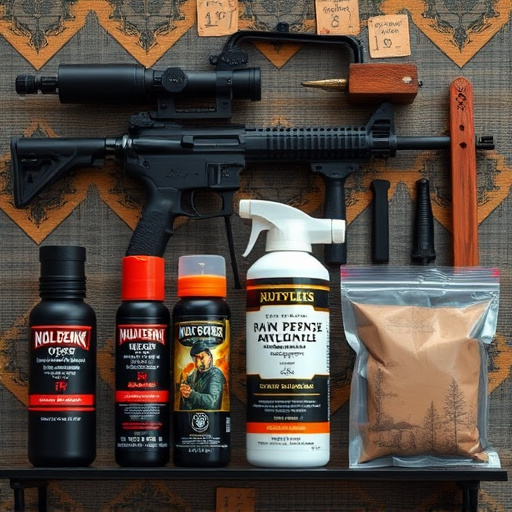Personal defense products, including Tasers, pepper spray, and stun guns, bridge the gap between conventional firearms and non-violent tactics. These innovative tools offer safer protection options, catering to law enforcement, military, and civilian self-defense needs. With varying legal frameworks globally, less lethal weapons like pepper spray, batons, and Tasers provide a strategic balance between protection and minimizing harm, while effective training ensures their responsible use in diverse scenarios.
“Personal defense is a crucial aspect of modern society, and the demand for effective yet less lethal weapons has never been higher. This comprehensive guide delves into the world of ‘less lethal’ options, exploring their evolution, diverse applications, and critical legal frameworks. From pepper spray to Tasers, we examine these tools’ types and uses, emphasizing responsible training and use. Understanding the nuances of safety and regulatory contexts is vital for ensuring effectiveness and minimizing risks associated with personal defense products.”
Understanding Less Lethal Weapons: A Comprehensive Overview
Less lethal weapons, also known as non-lethal or less than lethal force tools, are designed to incapacitate or control individuals without causing permanent harm or death. These innovative personal defense products have gained significant attention in recent years due to their potential to bridge the gap between conventional firearms and non-violent tactics. They offer a more nuanced approach to law enforcement, military, and civilian self-defense scenarios, allowing for effective restraint while minimizing the risk of fatal injuries.
The range of less lethal weapons includes various tools such as Tasers, pepper spray, stun guns, and ballistics designed to disrupt an individual’s mobility or sensory perception. Each type employs a different mechanism—from electric shocks that disrupt muscle control to irritants that cause temporary blindness or pain—to achieve neutralization. This comprehensive overview highlights the importance of understanding these weapons’ capabilities, limitations, and the specific contexts in which they are most effective, ensuring responsible and ethical use for personal safety and security.
The Evolution of Personal Defense Products
The world of self-defense has witnessed a remarkable evolution, and personal defense products have played a significant role in this transformation. Historically, individuals relied on traditional weapons like knives or batons for protection, but the need for safer and more accessible options became apparent. This led to the development of non-lethal force tools designed to incapacitate or deter attackers without causing permanent harm.
Modern personal defense products range from pepper spray and stun guns to advanced electronic devices that disrupt an assailant’s vision or communication. The market offers a wide array of options catering to different needs, such as personal safety during travel, everyday self-defense for individuals living in high-crime areas, or specialized training tools for law enforcement and military personnel. This diverse range of products reflects the growing demand for effective yet less lethal methods of self-protection.
Types and Applications: From Pepper Spray to Tasers
In the realm of personal defense products, less lethal weapons offer a balance between protection and minimizing harm. Among the most common types are pepper spray, batons, and Tasers. Pepper spray, a popular choice for self-defense, creates temporary blindness and irritation, allowing individuals to escape potential threats. Batons, often made of metal or high-impact plastic, provide a physical barrier and can be used to disable an assailant without causing permanent injury.
Tasers, on the other hand, use electrical current to disrupt muscle control, rendering a person temporarily immobilized. These devices are particularly useful in law enforcement situations where the primary goal is to incapacitate a suspect without lethal force. The versatility of less lethal weapons makes them accessible for various applications, including personal protection, police enforcement, and even military operations, ensuring safety while maintaining the ability to respond effectively to dangerous scenarios.
Legal Considerations and Regulatory Frameworks
The legal landscape surrounding less lethal weapons, including personal defense products, varies significantly across jurisdictions. In many countries, regulations are designed to balance citizens’ rights to self-defense with public safety concerns. These frameworks often dictate who can possess such weapons, where they can be carried, and under what circumstances they can be used. Compliance with local laws is crucial for individuals looking to purchase and employ less lethal options for personal defense.
Regulatory bodies typically set standards for weapon design, safety features, and training requirements. These measures aim to ensure that only qualified individuals handle these tools responsibly. The complexity of legal considerations underscores the importance of thorough research and understanding before acquiring any personal defense products, as adherence to local statutes not only ensures legality but also promotes a safer environment for all.
Safety, Training, and Responsible Use: Ensuring Effectiveness and Minimizing Risks
In the realm of personal defense, less lethal weapons represent a crucial balance between deterrence and minimizing harm. Safety is paramount; these tools are designed to incapacitate or deter without causing permanent disability or fatal injury. Effective training is essential for their responsible use. Law enforcement agencies and individuals alike must undergo comprehensive instruction to ensure they understand the mechanics, range, and potential consequences of each weapon. Only through rigorous training can users maximize effectiveness while minimizing risks.
Proper training includes not only learning how to operate the weapon but also understanding when its use is justified. It involves recognizing and assessing threats accurately, knowing legal implications, and developing sound decision-making skills. Responsible use extends beyond individual proficiency; it encompasses respect for local laws, storage security, and proactive measures to prevent accidental discharge or misuse. By adhering to these guidelines, users can leverage personal defense products effectively while upholding safety standards.
